
Tire type and correct periodic maintenance are important components in helping to promote smooth and efficient open-road performance and vehicle ride comfort. Tires have evolved since the first solid rubber tires appeared in the mid-1800s. During the next fifty years automobile tire design consisted of an inner tube that contained compressed air, and an outer casing that protected the inner tube and provided traction. Tire evolution changed tires to a radial design which helped provide better characteristics of longer tread life, and less rolling resistance. This article is intended to provide you with information on radial and run-flat tires, their maintenance and the use of sealants and pumps.
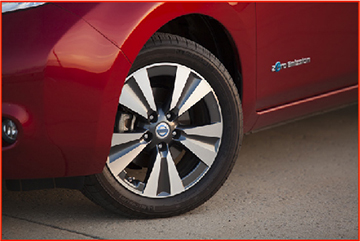
Radial Tires
Radial tires are the standard tire used today as current designs have helped improve gas mileage. They get their name from the way the plies are arranged in the tire. The plies run straight out at ninety-degree angles to the direction of travel from the wheel rim to the center of the tire just like rays extend from the sun. This design is intended to help prevent the plies from rubbing against each other as the tire flexes. The radial cords in the sidewall of a radial tire allow it to act like a spring, and the rigid steel belts help reinforce the tread region. Radial tires feature longer tread life, flexible sidewalls and quite a few components designed to provide the best acceleration, steering control and handling, ride comfort, fuel economy, and a quiet ride.
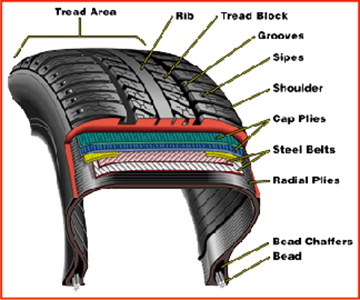
The tire contact patch (footprint) influences the tire’s performance. The aspect ratio of a tire consists of the width of the tire in relation to the height or diameter. Low profile tires have a short sidewall and a wide contact patch that is effective in converting the driver’s input into responsive handling, corner stability and traction.
The basic components of radial tires are:
- Bead - The bead consists of loops of stiff wire embedded in rubber. It anchors the tire to the wheel.
- Plies - Plies run across the tire from bead to bead and form the interior core of the tire.
- Belts - Belts lie directly beneath the tread, reinforcing and stabilizing it, which helps to improve tread wear.
- Cords - Cords are strands of steel, fiberglass, rayon, nylon or polyester that form the plies of a tire and help determine load capacity. The cords for a passenger car and a truck vary because the truck’s cords will be arranged so that it can handle a heavier load.
- Curb Guard- The curb guard is slightly wider than the wheel on the outside edge and helps protect the tire from damage if the driver happens to bump into a curb.
- Inner Liner - The inner liner forms the inside of a tubeless tire and keeps the air in.
- Shoulder - The shoulder is the outer portion of the tread where the tread and sidewall meet.
- Sidewall - The sidewall is the side of the tire that joins the tread and the beads.
- Sipes - Sipes are small slits in the tread that help evacuate water from the tread.
- Tread - The tread is the part of the tire that touches the road. Designs vary widely, depending on the purpose of the tire. The tread is responsible for traction and is composed of geometric designs. The deeper grooves in a tire are meant to channel rainwater.
- Tread Wear Indicators - Tread wear indicators (sometimes called wear bars) are built into the tread grooves as indicators to show when a tire needs to be replaced. After tread depth has worn down to 2/32 of an inch, the tread wear indicators are even with the tread to indicate that tire replacement is necessary.
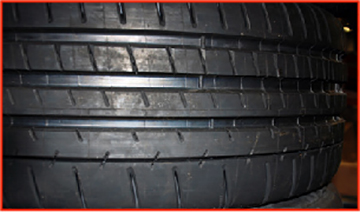
One of the main benefits of radial tires is that they are designed to allow the sidewall and the tread to act separately on the road. The sidewall’s flex does not transmit to the tread, and the tires function in such a way that more power is transferred from the vehicle to the ground. Belts allow the tires to wear slower and last longer. They also roll more easily and have less rolling resistance, improving fuel economy.
NOTE:
Keeping tires inflated to their specified cold tire pressures is the easiest
way to reduce rolling resistance. Under-inflated tires greatly affect fuel
efficiency and tire wear.
So what is rolling resistance? Rolling resistance has two causes: hysteresis and plastic deformation. In order to understand hysteresis, it is important to know that when a tire rolls on any surface, some energy is lost. The sidewall flexes underneath the weight of the vehicle, which is elastic deformation, meaning it is reversible deformation. As the tire goes around, the flex is released from one area of the tire and applied to a new area of the tire. As the flex snaps back and tire materials return to their original shapes, energy comes back into the tire, propelling the vehicle. According to the laws of physics, the energy of the snap back is always less than the energy that went into the flex. This simple fact goes to show how it is important to keep the proper amount of pressure in the tire to reduce the amount of potential energy lost when the sidewall snap’s and recovers its original shape. The easiest way to reduce rolling resistance is to make certain that the tires are properly inflated. The idea of rolling resistance and snap back may be easier to understand if we compare the force required to maintain the forward movement of a rubber tire with that of a steel wheel. Trains with steel wheels on steel rails will roll much farther than rubber tires on a vehicle driving on a paved road. Also, a soft surface, such as sand or mud, will have a higher rolling resistance, slowing the vehicle down more than on a hard surface, such as pavement.
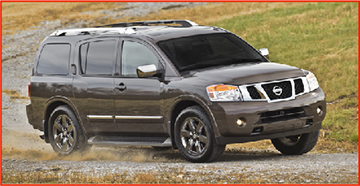
Plastic deformation is irreversible and is the change of an object’s shape due to force or temperature. The weight of a vehicle applies force while the pavement and friction add a heat factor. Tires have to be changed every couple of years, depending on the vehicle, because they lose their tread. So we know that plastic deformation happens to tires. Slippage falls into the plastic deformation category. Slippage is a term for the friction aspect between the wheel and the surface, which dissipates energy. Slippage also refers to the stresses and deformation of the tire. Radial tires helped reduce rolling resistance overall as opposed to the older standard, bias-ply tires, which had interdependent treads and sidewalls.
IMPORTANT NOTE: Tires degrade with age and use. Tires should be periodically inspected for wear, cracking, bulging or objects caught in the tread. If excessive wear, cracks, bulging or deep cuts are found, the tire(s) must be replaced. Tires may need to be changed every couple of years, depending on the vehicle, because they lose their tread. The original tires have built-in tread wear indicators. When the wear indicators are visible, the tire(s) should be replaced. When replacing a tire, use the same size, tread design, speed rating and load carrying capacity as originally equipped.
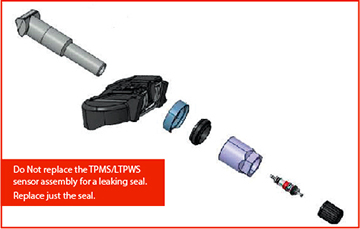
NOTE: TPMS/LTPWS wheel sensors must be registered each time the wheels are rotated, swapped or replaced. If TPMS sensors are removed from a wheel, the rubber grommet, valve core and retaining nut should be replaced. The TPMS/LTPWS seals can be the source of a tire low pressure condition and are available individually.
Run-flat Tires
A run-flat tire is a pneumatic vehicle tire. Run-flat tires are designed to resist the effects of deflation when they are punctured. They enable the vehicle to be driven at a reduced speed for a limited distance, and avoid hard cornering and hard braking. The primary benefit of using run-flat tires is continued mobility in case of loss of air pressure. Run-flat tires are currently available on the Nissan GT-R, the Nissan Rogue (equipped with 3rdrow seats), and the Infiniti Q50.
The GT-R uses specifically designed run-flat tires and matching road wheels to provide the greatest potential for maximum performance. The run-flat tires for the GT-R have rigid sidewalls requiring special equipment and procedures for replacing these tires. The disadvantages of run-flat tires are that for most brands only a specific wheel can be used and they cannot always be repaired when punctured. This is mainly because it is difficult to determine the state of the sidewall because the rubber is so thick and compact.
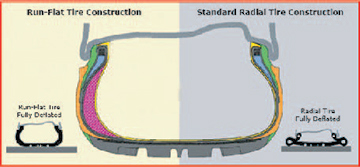
NOTE: Always use run-flat tires of the same specified size on all four wheels. Mixing tire sizes or construction may reduce vehicle handling stability.
NOTE: Use of non-genuine GT-R tires on GT-R vehicles may cause powertrain system damage, if the vehicle is driven in a flat tire situation, even if run-flat tires are used.
Self-supporting, run-flat tires typically enable the driver to drive no more than 50 miles, and not exceed more than 50 MPH after puncture because they are engineered with stiff, thicker sidewalls. The actual distance the vehicle can be driven on a flat tire depends on outside temperature, vehicle load, road conditions and other factors. The extra weight of the thicker sidewall adds 10 to 40 percent more weight to the tire, adding a little to hysteresis, but the benefits of the run-flat tire may outweigh the slight percentage of extra fuel consumption due to rolling resistance.
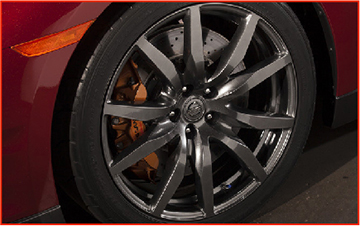
The GT-R has high performance, self-supporting, run-flat tires filled with nitrogen. Nitrogen molecules are larger than air molecules, and nitrogen migrates slower than air. This means that nitrogen filled tires stay at the correct pressure for longer periods of time under a wider variety of usage and atmospheric conditions. The Rogue has standard run-flat tires on vehicles equipped with optional third-row seating. Drivers with run-flat tires should frequently check the tire pressure and adjust pressure of each tire properly. The tire pressure can be also checked in the vehicle information display. You should always use a reliable tire pressure gauge to ensure that the customer’s vehicle cold tire pressures are correct because it is difficult to tell when a run-flat tire is flat.
The most important thing to note about run-flat tire repair is that unlike radial tires, which are easily repaired, most tire manufacturers’ guidelines recommend replacing punctured run-flat tires instead of patching them. At most, a one patch maximum is recommended. If the tire sealant that is equipped in the cars with run-flat tires has been used, it must be thoroughly cleaned off the inner liner. Do not inject any tire liquid or aerosol tire sealant into the tires, as this may cause a malfunction of the tire pressure sensors.
NOTE: Hunter’s Auto34 Tire Changer is very useful and easy to use when working with 18-inch or larger rim diameters with low profile tires or run-flats.
Tire Pressure Monitoring System
Since 2006, new vehicles, including all Nissan and Infiniti vehicles, have Tire Pressure Monitoring Systems (TPMS). All of our vehicles feature the direct system. The TPMS monitors tire pressure of all tires (with the exception of the spare). If the vehicle is being driven with one or more tires significantly under-inflated, the TPMS will activate and warn the driver by activating the low tire pressure warning light (in the instrument panel). This system will only activate when the vehicle is driven at speeds above 16 MPH (25 km/h).
When one or more of the tires is low on air, the indicator illuminates SOLID immediately and remains SOLID until the air pressure is corrected in the tire(s).
When there is a fault in the system, the indicator FLASHES FOR ONE MINUTE and then illuminates and stays ON for the remainder of the key cycle. The FLASHING-THEN-SOLID sequence occurs again at each successive key cycle while the fault remains current.
The SOLID illuminated TPMS warning light will extinguish (if it is being displayed) when the fault is corrected.
If the vehicle is running on a flat tire, the low tire pressure warning light will stay ON and a chime will sound. If so equipped, a “Tire Pressure Low Add Air” warning light will also continuously illuminate. The vehicle will not always detect the flat tire while it is in motion. Nissan and Infiniti Owners’ Manuals recommend driving no more than 50 miles at no more than 50 MPH on a spare tire. When a spare tire is mounted or a wheel is replaced, the low tire pressure warning light will flash for approximately 1 minute and then remain ON until the system is reset.
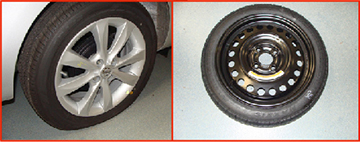
NOTE: Periodically check the spare tire inflation pressure. Always keep the pressure of the TEMPORARY USE ONLY spare tire at 60 psi (420 kPa, 4.2 bar).
Tire Maintenance
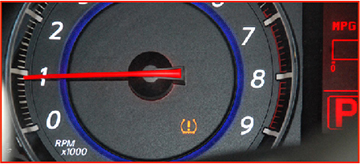
There are a few things to note about tire maintenance. First, on cars that have four of the same size tires, Nissan recommends rotating the tires every 7,500 miles, (on 2014 and later model years every 5,000 miles) in order to avoid uneven tire wear. The front wheels move to the back and vice versa. After rotating the tires, adjust the tire pressure to the cold tire pressure specification shown on the Tire and Loading Information label. When a tire is significantly low in pressure, the TPMS warning light will illuminate and stay ON. If the TPMS warning light is flashing, there is a malfunction other than low tire pressure. The TPMS light will reset faster if the tires are inflated while the vehicle is ON with the engine OFF. Vehicles built prior to 2009 will need to be driven at speeds above 16 MPH in order to reset the TPMS low tire pressure indicator light. Back in 2012, Nissan first released the Easy Fill Tire Alert system on some models. It functions to help eliminate the need for a tire gauge. Vehicles equipped with TPMS with Easy Fill Tire Alert informs the driver with a visual and audible indication to alert them when the tire is being filled and reaches its recommended cold tire pressure specification. This feature functions when the vehicle is in P (Park) and the ignition is in the ON position.
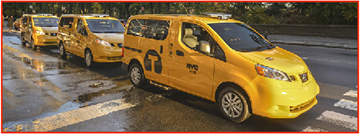
Tire Sealant and Pump
Vehicles that do not have a spare tire or run-flat tires may be equipped with emergency tire puncture kits. A tire sealant and pump come standard in some Rogue, 370Z, Q60 Convertible and LEAF vehicles. The emergency tire puncture kit contains a tire sealant bottle and an air compressor with a hose and power plug. All of these things must be replaced after each use. To use the kit, the latex bottle must be connected to the pump and the pump plugged into the vehicle’s 12-volt outlet. After the pump is used, the car should be driven less than 100 miles at speeds below 50 MPH.
NOTE: The emergency repair compound may plug or cause a malfunction of the tire pressure sensors and cause the low tire pressure warning light to illuminate. If a customer has used the tire sealant to repair a tire, replacement of the tire pressure sensor may be necessary.
Driving on well-maintained tires is an easy way to have the best ride possible. In the big picture of the automobile, the ride and its longevity, tires are literally the foundation from which the car will gain speed, come to a stop, or just keep rolling. Therefore, their maintenance and care are of the utmost importance. The more you know about them, the better!
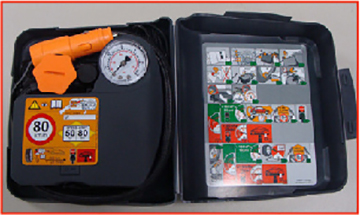
![]()
- Aftermarket tire sealants and/or aerosol repair kits should not be used (refer to the vehicle’s Owner’s Manual).
- Some aftermarket tire sealers and/or aerosol repair kits contain chemicals and propellants that can cause damage to TPMS sensors.
- Damage caused by use of aftermarket tire sealants is not covered under the Nissan New Vehicle Limited Warranty.